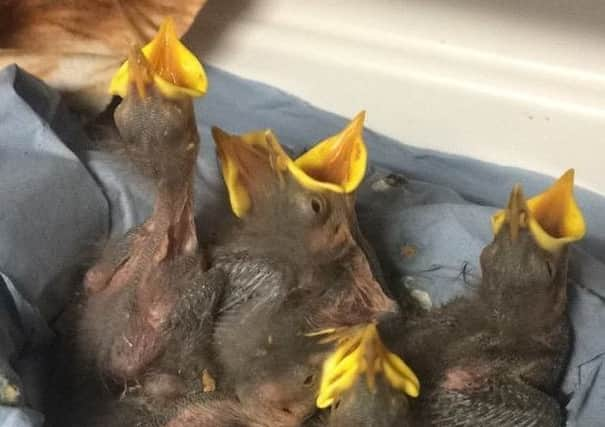TREVOR WEEKS: Please be careful when handling fledgling birds


Some have been turfed out of their nest, others have been caught by predators, and some have had their nests destroyed by hedge cutting or garden work.
It is very easy to assume a bird has been abandoned when you find it on the floor, but quite often it is a fledgling learning to fly.
Advertisement
Hide AdAdvertisement
Hide AdWhen a fledgling takes its first flight it is going to be unsuccessful, it is natural for them to spend between 12hours and five days on the floor (depending on species) before they can fly properly.
Mum and dad will normally be near by but they do not always fly down to feed every few minutes as they are trying to encourage the youngster to fly.
Both the youngster and the parents are good at hiding themselves.
Parent birds will encourage their young to disperse into different hide-ways where they will carry on feeding them.
Advertisement
Hide AdAdvertisement
Hide AdThis is nature’s way of spreading the risk of the youngsters getting taken by a predator. Clustered in the nest they would be easy prey for any bird or other animal that detected it.
This natural system of dispersal has worked for millions of years and has worked successfully.
Some will be taken as these small garden birds form part of natures food chain helping other wild animals and birds to survive.
For this reason, juvenile and fledgling birds should be left alone. However there are some situations of man-made origin that means you should intervene.
There are three stages at which birds are found.
Advertisement
Hide AdAdvertisement
Hide AdAs a chick, nestling and as a fledgling. There is a lot of confusion about when they should or shouldn’t be picked up.
If you come across a chick out of the nest, please pick it up, as it will not survive, and give a rescue organisation a call.
Chicks are generally those which are either bald, or are covered in fluff.
The nest stage is nestlings which are covered in fluff or developing their feathers and have bald patches under their wings.
Advertisement
Hide AdAdvertisement
Hide AdThese also are too young to be out of the nest and should be picked up and a rescue organisation called for help.
The final phase is fledglings which are fully feathered, with no bald patches nor fluff on them.
In most species of fledgling the wing tips, when at rest on their back’s will be touching and crossing over just above the base of the tail.
These fledglings should be left alone unless sick, injured or in immediate danger like in a road and about to be run over by a car, but also if both parents have definitely been killed or incapacitated.
Advertisement
Hide AdAdvertisement
Hide AdFledglings should not be picked up just because there are predators about, as there is no such thing as a predator safe locations and all gardens are visited by predators be them cats, foxes, gulls, corvids or birds of prey.
This is a complex issue, some species of baby birds like ducklings and pheasant chicks are able to feed themselves straight after hatching but other species like moorhen and partridge need help.
Some species of young bird will climb up and down tree trunks, like tawny owls.
You can reduce the chances of a young bird surviving by bringing it into care and hand rearing.
Advertisement
Hide AdAdvertisement
Hide AdIt is surprising how many avoid capture by cats and other prey by hiding in bushes and vegetation.
The risk of being caught by a cat or taken by predators is frequently less than the risks of them coming into care and not having their parents teach them how to survive.
Every year we get calls from people who have fed a baby bird or mammal milk. Unlike mammals, birds do not have breasts and do not produce milk. This is bad for their digestive system.
If you feel you need to give any wild animal or bird something to drink then please stick to giving it water.
Advertisement
Hide AdAdvertisement
Hide AdEvery year WRAS is asked to take on birds which have been hand reared on their own or as a pair and have become domesticated.
It is important that birds are not reared on their own but with others of their own species to ensure they learn life survival skills and compete for food. Handling should be kept to a minimum to ensure they are not tamed and can be released back into the wild.
It is always best to seek advice and help if you find any baby or orphaned wild animal or bird.
This column has been kindly provided by Trevor Weeks MBE